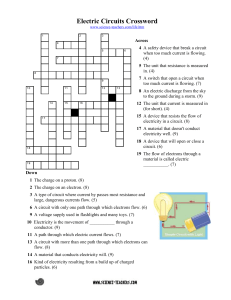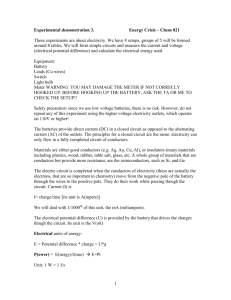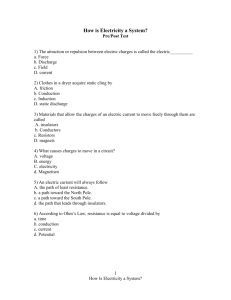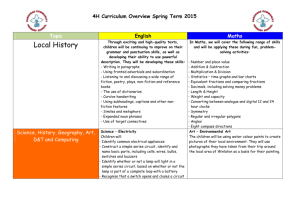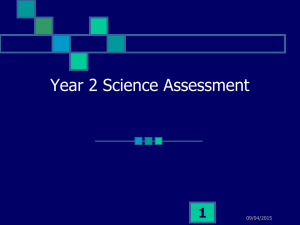ELECTRICITY UNIT
advertisement
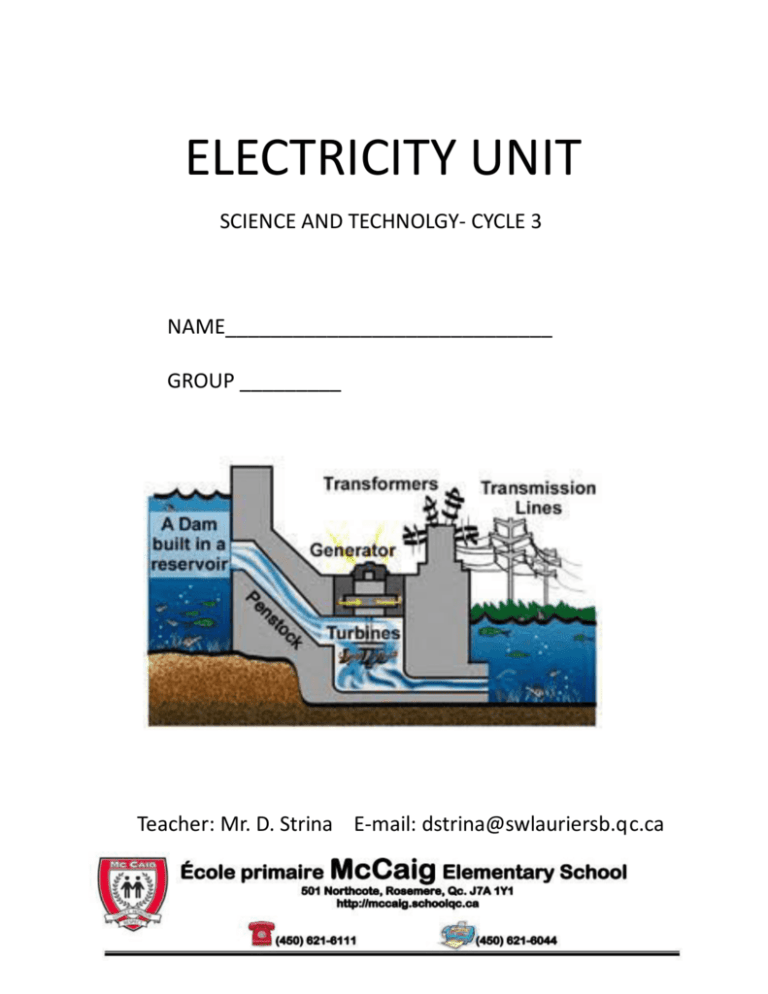
ELECTRICITY UNIT SCIENCE AND TECHNOLGY- CYCLE 3 NAME_____________________________ GROUP _________ Teacher: Mr. D. Strina E-mail: dstrina@swlauriersb.qc.ca MC CAIG ELEMENTARY SCHOOL CLASS NOTES--Atom An atom is the smallest particle characterizing an element. All matter in the universe is made up of a combination of different atoms. Atoms are made up of protons, neutrons and electrons. Electrical charge An electrical charge is produced when an atom loses or gains an electron. When there are more electrons than protons, the charge is negative. When there are fewer electrons than protons, the charge is positive. The unit of electrical charge is the coulomb (symbol: C). Electrical current An electrical current is the movement of negative electrical charges (electrons) through a conductor (electrical wire, metal foil, etc.). In an electrical circuit, the current flows from the point where the electrical potential is highest to the point where it is lowest. Electrical circuit An electrical circuit is the complete loop through which an electrical current flows. It is made up of a series of electrical components and conductors (e.g., batteries, electrical wires, light bulbs, etc.). The current only flows in an electrical circuit when the path is completely closed, forming a loop. 1 Types of electrical circuit There are two types of electrical circuit, parallel circuits and series circuits. Parallel circuits provide several different paths for the electrical current. Series circuits force the current through a single path; in other words, the electricity flows through all the electrical components of a series circuit one after the other. Conductors of electricity Conductors are bodies or materials that allow an electrical current to pass through them. Copper, aluminum, brass, zinc, iron and pewter are examples of metal that conduct electricity well. Salt water is also a good conductor. Resistance Resistance is the part of an electrical circuit that resists the flow of electricity (for example, by transforming it into heat or light, as in a light bulb or a buzz er). In an electrical circuit, the presence of a resistor limits the current and prevents damage related to short circuits. The unit used to measure resistance is the ohm (symbol: Ω). Ampere The ampere (symbol: A) is the unit used to measure current intensity. 2 Voltage Voltage (symbol: V) is the unit used to measure electrical tension, also called “difference of electrical potential.” Short circuit A short circuit occurs when two live (i.e., carrying current) conductors accidentally come into contact, either directly or through a conducting object (e.g., when the blade of an electric lawn mower cuts the electrical wire). When this happens, the current can flow with very little restriction because the resistance of the loop formed by the two conductors is very weak. The high amount of current heats up the wires and can cause a fire. Fuses and circuit breakers detect unusually high currents and break the circuit, which helps to prevent fires. Battery Batteries are reserves of chemical energy that can be transformed into electrical energy. Small electric cells (commonly called batteries, as in AA batteries) are examples of simple batteries for everyday use. Insulator Insulators, such as wood and plastic, are materials that do not easily transmit heat, cold or electricity. Electrical wires are covered with an insulator to prevent electrical shocks and short circuits that could cause fires. 3 People Thomas Alva Edison (1847-1931), a U.S. inventor who designed the first electric light bulb. He also invented many other devices, including the phonograph, ancestor of the gramophone. Alessandro Volta (1745-1827), an Italian physicist, invented the first electric battery. 4 1 STAPLE STAPLE AC M E Name: //////// Electricity from the wall outlets in your house powers your television, computer, lights, and microwave. Cell phones, flashlights, and even a car’s headlights are powered by the electricity in batteries. Super Teacher Worksheets - www.superteacherworksheets.com Super Teacher Worksheets - www.superteacherworksheets.com 2 3 light circuit box switch wire The type of electricity that is used to power things we use is called current electricity. Current electricity is electricity that flows through wires. The path that electricity follows is called a circuit. 5 Super Teacher Worksheets - www.superteacherworksheets.com STAPLE STAPLE outlet The picture above shows a circuit. Electricity flows from the negative side of a battery, through the wires, and lights the bulb. The electricity continues to travel around to the positive side of the battery. Draw arrows on the picture to show the path of the electricity. Super Teacher Worksheets - www.superteacherworksheets.com Something that uses some of the electricity in a circuit is called a resistor. Resistors could also be things like light bulbs, motors or speakers. STAPLE 5 A circuit can be open or closed. When a circuit is closed, it is complete and there is no break in the path that the charges must follow. When a circuit is open, it is incomplete and charges can’t flow through. Super Teacher Worksheets - www.superteacherworksheets.com Super Teacher Worksheets - www.superteacherworksheets.com 6 7 STAPLE Color the resistors in the circuit above. Label the two circuits above with the words “open circuit” and “closed circuit.” STAPLE STAPLE 4 A switch is sometimes added to a circuit. The switch opens and closes a circuit to turn resistors on and off. Label the two circuits above with the words “series circuit” or “parallel circuit.” Color the switch in the circuit above. Super Teacher Worksheets - www.superteacherworksheets.com In a series circuit, electricity can follow only one path. In a parallel circuit, electricity has more than one path to follow. 6 Super Teacher Worksheets - www.superteacherworksheets.com Name: ____________________________________ Electricity Choose the best answer for each question. Write the letter on the line. __________ 1. __________ 2. What supplies energy in an electric circuit? a. a conductor b. light bulb c. a wire d. a battery Which material is a conductor? a. plastic b. silver c. glass d. wood Circuit A __________ 3. __________ 4. __________ 5. Which type of circuit is Circuit A? a. series b. parallel c. perpendicular d. current Which item is a resistor in Circuit B? a. light bulb b. wire c. battery d. screws Circuit B Why did the person who made Circuit A probably connect the wires to a penny? a. They needed to use a penny to make the bulb light. b. They were testing to see if the penny conducts electricity. c. They used the penny to supply extra power. d. The penny will prevent sparks. __________ 6. Which of these could be used as a resistor in a circuit? a. a pencil b. a gas engine c. a rubber eraser d. an electric motor 8 Super Teacher Worksheets - www.superteacherworksheets.com Name: Electrical Charges If an object has more positive charges ( ) than negative charges ( ), its electrical charge is positive ( ). If an object has more negative charges ( than positive charges ( ), its electrical charge is negative ( ). Example: ) If an object has the same number of positive ( ) and negative ( ) charges, it has no electrical charge or is neutral. Electrical charge: positive charge Count the positive and negative charges in each picture. Write positive charge, negative charge, or no charge on each line. 1. 2. electrical charge: electrical charge: 3. 4. electrical charge: electrical charge: 5. 6. electrical charge: electrical charge: 9 Super Teacher Worksheets - www.superteacherworksheets.com Name: ____________________________________ Static Electricity Rubbing a balloon with wool cloth will create static electricity charges. In Picture 1, does the balloon have a positive charge, negative charge, or no charge? ______________ In Picture 1, does the cloth have a positive charge, negative charge, or no charge? __________________ In Picture 2, does the balloon have a positive charge, negative charge, or no charge? ______________ In Picture 2, does the cloth have a positive charge, negative charge, or no charge? ______________ If you place small pieces of tissue paper near the balloon in Picture 2, they would probably stick to the balloon. Explain why. ___________________________________________________________________________________________________ ___________________________________________________________________________________________________ ___________________________________________________________________________________________________ ___________________________________________________________________________________________________ Super Teacher Worksheets - www.superteacherworksheets.com 10 Circuits A circuit always needs a power source, such as a battery, with wires connected to both the positive (+) and negative (-) ends. A battery is also known as a cell. A circuit can also contain other electrical components, such as bulbs, buzzers or motors, which allow electricity to pass through. Electricity will only travel around a circuit that is complete. That means it has no gaps. Incomplete circuit Complete circuit Symbols We use these symbols to draw diagrams of circuits: 20 Switches When a switch is open (off), there is a gap in the circuit. Electricity can not travel around the circuit. When a switch is closed (on), it makes the circuit complete. Electricity can travel around the circuit. Switch open (off). Bulb doesn't light. Switch closed (on). Bulb lights. 21 Changing circuits Adding more batteries to a simple circuit will increase the electrical energy, which will make a bulb brighter. More bulbs Adding more bulbs to a simple circuit will make the bulbs dimmer. Longer wires Lengthening the wires in a simple circuit will make the bulb dimmer. 22 Electrical circuits - Quiz 1. In a simple series circuit, why does the bulb light when you close the switch? a-Because the switch produces electricity b-Because closing the switch completes the circuit c-Because closing the switch breaks the circuit 2. In a simple series circuit, why does the bulb go out when you open the switch? a-Because the battery goes flat b-Because opening the switch breaks the circuit c-Because too much electricity flows through the bulb 3. Imagine a simple series circuit with one 1.5V battery and one bulb. When the 1.5V battery is replaced with a 3V battery ... A- the bulb gets brighter b- the bulb gets dimmer c-the bulb stays at the same level of brightness 4. Imagine a circuit with a 1.5V battery and one bulb. Imagine a similar circuit with a 3V battery and two bulbs. Which has the brightest bulbs? a-The circuit with a 1.5V battery and one bulb b-The circuit with a 3V battery and two bulbs c-The bulbs in both circuits are of similar brightness levels 5. Why might a bulb flash and go out when a 1.5V battery and a 3V battery are both connected across it in a simple series circuit? a-There is not enough electricity flowing around the circuit b-Too much electricity flows through the bulb's filament and the bulb blows c-The batteries are flat 6. What is the effect of changing the wire in a circuit from a straight thick wire to a straight thin wire? a-The bulbs become dimmer b-The bulbs become brighter c-The bulbs stay at the same level of brightness 7. What is the effect of changing the wire in a circuit from a straight thick wire to a longer (coiled) thick wire? a-The bulbs become dimmer b-The bulbs become brighter c-The bulbs stay at the same level of brightness 8. In a circuit diagram, what does a circle with a cross inside it represent? a-A light bulb b- A motor c- A battery 9. What do the long straight lines represent in a circuit diagram? a-Motors b-Light bulbs c- Wires 10. How is a battery represented in a circuit diagram? a-A circle with a cross inside it b- A circle with an M inside it c-A long line and a short line 23 Series & parallel circuits There are two types of circuit we can make, called series and parallel. The components in a circuit are joined by wires. if there are no branches then it's a series circuit if there are branches it's a parallel circuit Series circuits In a television series, you get several episodes, one after the other. A series circuit is similar. You get several components one after the other. If you follow the circuit diagram from one side of the cell to the other, you should pass through all the different components, one after the other, without any branches. If you put more lamps into a series circuit, the lamps will be dimmer than before. In a series circuit, if a lamp breaks or a component is disconnected, the circuit is broken and all the components stop working. Series circuits are useful if you want a warning that one of the components in the circuit has failed. They also use less wiring than parallel circuits. 23 Parallel circuits In parallel circuits different components are connected on different branches of the wire. If you follow the circuit diagram from one side of the cell to the other, you can only pass through all the different components if you follow all the branches. In a parallel circuit, if a lamp breaks or a component is disconnected from one parallel wire, the components on different branches keep working. And, unlike a series circuit, the lamps stay bright if you add more lamps in parallel. Parallel circuits are useful if you want everything to work, even if one component has failed. This is why our homes are wired up with parallel circuits. 24 Name: _______________________ Series and Parallel Circuits In a series circuit electric current has only one path to follow. All parts are connected one after another. Electric current flows from the negative side of the battery around in a loop to the positive side. Draw arrows to show the path of electric current in this series circuit. If a light bulb is missing or broken in a series circuit, will the other bulb light? Explain. _________________________________________________________________________________________________ _________________________________________________________________________________________________ In a parallel circuit, electric current has more than one path to follow. The electric current can follow different paths as it flows from the negative side of the battery to the positive side. Draw arrows to show the different paths electric current can travel in this parallel circuit. If a light bulb is missing or broken in a parallel circuit, will the other bulb light? Explain. _________________________________________________________________________________________________ _________________________________________________________________________________________________ Super Teacher Worksheets - www.superteacherworksheets.com 11 Name: Electrical Circuits Tell whether the light bulb or bulbs will light or will not light based on the circuit. 1. 2. 3. 4. 5. 6. 12 Super Teacher Worksheets - www.superteacherworksheets.com Name: Series & Parallel Circuits Tell whether each picture shows a series circuit or parallel circuit. 1. 2. type: type: 3. 4. type: type: 5. 6. type: type: 13 Super Teacher Worksheets - www.superteacherworksheets.com Name: _______________________ What's Wrong With These Circuits? 1. Explain why the light bulbs won't light in the circuit pictured on the right. _________________________________________________________ _________________________________________________________ _________________________________________________________ _________________________________________________________ 2. Explain why the light bulb isn't lighting up in the circuit pictured on the right. _________________________________________________________ _________________________________________________________ _________________________________________________________ _________________________________________________________ 3. Explain why the light bulb isn't lighting up in the circuit pictured on the right. _________________________________________________________ _________________________________________________________ _________________________________________________________ _________________________________________________________ Super Teacher Worksheets - www.superteacherworksheets.com 14 25 Electrical conductors – Introduction Electricity travels easily through electrical conductors, like metals. Materials that do not let electricity pass through them easily are called electrical insulators. Plastic, wood, glass and rubber are good electrical insulators. Electrical conductors Some materials let electricity pass through them easily. These materials are known as electrical conductors. Many metals, such as copper, iron and steel, are good electrical conductors. That is why the parts of electrical objects that need to let electricity pass through are always made of metal. Metal is used in plugs to allow electricity to transfer from the wall socket, through the plug, and into a device such as a radio or TV. In a light bulb, the metal filament conducts electricity and causes the light bulb to light up. 17 Electrical insulators Some materials do not allow electricity to pass through them. These materials are known as electrical insulators. Plastic, wood, glass and rubber are good electrical insulators. That is why they are used to cover materials that carry electricity. The plastic covering that surrounds wires is an electrical insulator. It stops you from getting an electrical shock. 18 Electrical conductors – Quiz– Circle the best answer 1. A material that lets electricity pass through it is called ... a-an electrical conductor b-an electrical insulator c- an electrical appliance 2. A material that does NOT let electricity pass through it is called ... a-an electrical conductor b- an electrical insulator d-an electrical appliance 3 .Which of the following materials is an electrical conductor? a-Silver b- Silver-coloured plastic c-Cork 4. Which of the following materials is an electrical insulator? a-Aluminum b-Gold c- Rubber 5. In which circuit will the bulb or bulbs glow brightest? a-A simple circuit with one bulb and one battery b-A simple circuit with one bulb and two batteries c-A simple circuit with two bulbs and one battery 6. Why is a bulb brighter when it is powered by two batteries rather than one? a-Because the flow of electricity in the circuit is less b-Because the flow of electricity in the circuit is the same c-Because the flow of electricity in the circuit is greater 7. Ruby has connected two bulbs across two batteries in a simple circuit. How can she make the bulbs dimmer? a-Replace one of the batteries with a section of wire b-Replace one of the batteries with a cork c-Replace one of the bulbs with a section of wire 8. Ruby makes a complete simple circuit with one bulb and three batteries. The bulb lights for an instant and then goes out. Why? a-Not enough electricity flows around the circuit b-Too much electricity flows through the bulb's filament c-The batteries are flat 9. Why is electrical wiring usually made from copper? a-Because copper is shiny b- Because copper conducts electricity c-Because copper is not magnetic 10. Why is electrical wiring usually covered with a layer of plastic? a-To make it look pretty b-To help electricity flow along the wire c-To make it safe 19 Name: _______________________ Conductors and Insulators A conductor is a material that allows electricity to flow through it. An insulator is a material that electricity cannot flow through. To determine whether an object is a conductor or insulator, you can build a simple circuit with a battery, light bulb, and three pieces of wire. Touch the free ends of the wire to the object you are testing. If the light bulb lights up, the object is made from a conductor. if it does not, the object is made from an insulator. Complete the table. Predict whether each item is made from a material that is a conductor or insulator. Then test each item to determine if it is made from a conductor or insulator. Object Prediction: Conductor or Insulator? Result: Conductor or Insulator? rubber band penny nickel toothpick key paper clip brass paper fastener glass microscope slide (your choice) (your choice) Super Teacher Worksheets - www.superteacherworksheets.com 15 Name: ____________________________________ Electricity circuit glass insulators conductors electric current rubber series parallel resistor copper battery silver Chose the best word(s) from the word box to complete each sentence. 1. The flow of electricity is an __________________________________________. 2. A path that an electric current follows is a ____________________________. 3. A ____________________________ supplies energy to move electricity through a circuit. 4. __________________________ are materials that electrical current cannot pass through. 5. __________________________ are materials that electrical current can easily pass through. 6. ____________________________ and ____________________________ are examples of materials that are conductors. 7. ____________________________ and ____________________________ are examples of materials that are insulators. 8. A ____________________________ is a material that cuts down the flow of current, but does not stop it. 9. A ____________________________ circuit is a circuit in which electrical current can follow only one path. 10. A ____________________________ circuit is a circuit in which electrical current has more than one path to follow. Super Teacher Worksheets - www.superteacherworksheets.com 16 Non Renewable Resources Non-renewable We get energy from many different types of energy resources, including fuels, food and stores of energy such as batteries or the wind. We can divide energy resources into two categories: nonrenewable and renewable. Non-renewable energy resources cannot be replaced once they are all used up. Renewable energy resources can be replaced, and will not run out. On the this page we'll look at non-renewable resources. Coal, oil and natural gas are called fossil fuels. They formed millions of years ago from the remains of living things. Coal was formed from plants. Oil and natural gas were formed from sea creatures . The energy stored in the fossil fuels originally came from sunlight. Plants used light energy from the Sun for photosynthesis to make their chemicals. This stored chemical energy was transferred to stored chemical energy in animals that ate the plants. When the living things died, they were gradually buried by layers of rock. The buried remains were put under pressure and chemical reactions heated them up. They gradually changed into the fossil fuels. When the remains of the plants and animals became fossil fuels, their chemical energy was stored in the fuels. The energy is transferred to the surroundings as thermal energy and light energy when the fuels burn. Once we have used them all up, they will take millions of years to replace, if they can be replaced at all. For this reason we call fossil fuels nonrenewable energy resources. 26 Renewable resources Renewable energy resources can be replaced, and will not run out. Be careful - it is not true to say that they can be re-used. Biomass Biomass fuels come from living things. Wood is a biomass fuel. As long as we continue to plant new trees to replace those cut down, we will always have wood to burn. Just as with the fossil fuels, the energy stored in biomass fuels came originally from the Sun. Wind power Wind is caused by huge convection currents in the Earth's atmosphere, driven by heat energy from the Sun. The moving air has huge amounts of kinetic energy, and this can be transferred into electrical energy using wind turbines. Wind turbines cannot work if there is no wind, or if the wind speed is so high it would damage them. Solar cells Solar cells are devices that convert light energy directly into electrical energy. You may have seen small solar cells on calculators. Larger arrays of solar cells are used to power road signs, and even larger arrays are used to power satellites in orbit around Earth. Solar panels Solar panels are different to solar cells. Solar panels do not generate electricity. Instead they heat up water directly. A pump pushes cold water from a storage tank through pipes in the solar panel. The water is heated by heat energy from the Sun and returns to the tank. They are often located on the roofs of buildings where they can receive the most sunlight. 27 Water power Moving water has kinetic energy. This can be transferred into useful energy in different ways. For example: wave machines use the up and down movement of waves to turn electricity generators dams are built across the mouths of rivers. As water moves in or out of the river mouth when the tide turns, the kinetic energy in the water is used to turn electricity generators. Hydroelectric power (HEP) schemes store water high up in dams. The water has gravitational potential energy which is released when it falls. As the water rushes down through pipes, this stored energy is transferred to kinetic energy, which turns electricity generators. An energy transfer diagram for an HEP scheme: Geothermal In some places the rocks underground are hot. Deep wells can be drilled and cold water pumped down. The water runs through fractures in the rocks and is heated up. It returns to the surface as hot water and steam, where its energy can be used to drive turbines and electricity generators 28 GRADE 6REVIEW--ELECTRICITY EXAMELECTRICITY NAME___________________________________ Part 1 Choose the best word. atom battery Benjamin Franklin switch volt current magnet wire dam Thomas Edison negative neutron Albert Einstein Michael Faraday shock static Alessandro Volta 1-Motors work because electricity in a coil makes one of these. ________________ 2-All matter is made up of one of these. ___________________________ 3-A “metal” string that brings electricity to your house. _________________ 4-The charge an electron has spinning around a nucleus. ___________________ 5-The part of a nucleus with neither a positive nor a negative charge. __________________ 6-Being careless with electricity can cause this! _____________________ 7-What turns electricity “on” and “off”. _________________________ 8- The kind of electrical energy that stays in one place. __________________ 9- A measure of the electric force that “pushes” electrons. ____________________ 10- Electrical energy can be stored in a ____________________. (also known as DC current) 11- A big structure that holds back water.________________________________ 12- Scientist responsible for the invention and a new way of producing light._____________________ 13- American scientist that used a kite to demonstrate static electricity. _______________________ 14- Italian Physicist who invented the first battery. Alessandro Volta 15- British Scientist who discovered that if an electric conductor, like a copper wire, is moved through a magnetic field, electric current will flow (or "be induced") in the conductor. So the mechanical energy of the moving wire is converted into the electric energy of the current that flows in the wire. Michael Faraday /13 Part 2- Questions 1-What is electricity? _____________________________________________________________ _____________________________________________________________ _____________________________________________________________ /2 2917 Part 3- Chose the best form of energy. Then circle if the energy is Renewable or Non-Renewable Solar Energy Geothermal Energy Hydro-Electrical Energy Wind Energy Nuclear Energy Fossil Fuels Energy 1-Energy from the heat deep in the earth is called: Geothermal Energy Renewable/Non-Renewable 2- Spinning windmill blades turn a turbine to create electricity:________________________________ Renewable/Non-Renewable 3-Power comes from the energy of falling water. ___________________________________ Renewable/Non-Renewable 4- Tiny atomic particles of uranium fuel this type of power.__________________________________ Renewable/Non-Renewable 5- Source of energy that uses the sun. ___________________ Renewable/Non-Renewable 6- Source of energy that uses coal, oil, and natural gaz. _________________________________ Renewable/Non-Renewable /9 Part 4- ATOMS--Describe the type of charge they have. Type of Charge (-,+, Neutral) Electron- ___________________ Neutron- ___________________ Proton - ___________________ Use the words on the side to draw and label the structure of the Atom. /3 /3 /6 18 30 Part 5- Decide which material is a conductor and which is an insulator. Iron ___________________ rubber_______________ wood ________________ copper ______________ aluminum ____ ___________ glass ________________ salt water _____________ gold_____________ leather ______________ plastic ___________ /5 Part 6- Look at the picture below and match the parts of the hydroelectric generating station with their definitions. /6 #____ # _____ #____ Part 7- What did Thomas Edison have to do to make the light bulb work? Explain . #_____ #_______ #_____ /1 ______________________________________________________________________ ______________________________________________________________________ ______________________________________________________________________ 19 31 Part7- Use the following words to match the pictures: parallel circuit, series circuit /2 a-_______________________ b-________________________ Part 8- Which circuit is better? Explain. /1 ______________________________________________________________________ ______________________________________________________________________ ______________________________________________________________________ ______________________________________________________________________ Part 9- What are the three main parts of a circuit? 1-___________________ 2-_____________________ /3 3-________________ Part 10- What are fuses and breakers? Why are they important? /2 ______________________________________________________________________ ______________________________________________________________________ ______________________________________________________________________ ______________________________________________________________________ 2032
